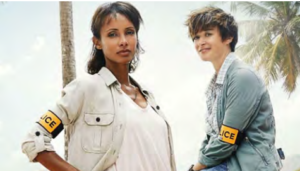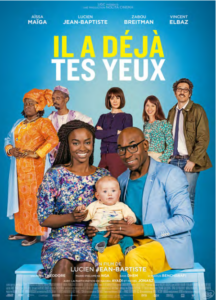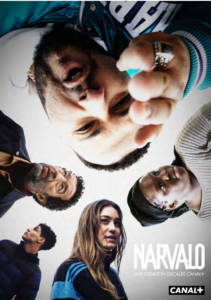FOCUS
#01
French series and diversity: an improvement yet to confirm
By Alexandre Diallo, postdoctoral researcher at Paris 1 Sorbonne University, course lecturer at SciencesPo Paris and affiliate researcher of the Maurice Halbwachs Centre (EHESS-ENS-CNRS) and Céline Morin, senior lecturer, director of the Information- Communication Department at Paris-Nanterre University, affiliate researcher of the HAR / Irméccen Laboratory (Paris Nanterre / Sorbonne Nouvelle).
Overview: the consumption of fiction series by the French public comes with two phenomena linked to the influence of images that needs to be reinforced: the strengthening of the importance of female actors in the latest popular fictions and the timid advance of ethnic diversity on screen.
Series are among the most popular TV programmes. In 2019, the two highest audience ratings for France 3 were for the airing of Captain Marleau (8,600,000 viewers, corresponding to a 33.6% of audience share on April 9, 2019 and 8,100,000, corresponding to a 30.1% of audience share on October 22, 2019). On TF1, the series Le Bazar de la Charité was the channel’s 3rd best audience the French team’s matches at the Women’s Football World Cup and the entertainment programme Le Monde des Enfoirés with 8,200,000 (32% of audience share) on 18 November. These two French series, as well as Julie Lescaut (TF1, 1992-2014), Joséphine Ange Gardien (TF1, 1997-) or Plus Belle la Vie (France 3, 2004-) reached ratings close to those of American TV series such as CSI: Crime Scene Investigation (TF1, 2003-2013), Grey’s Anatomy (TF1, 2006- ) or The Mentalist (TF1, 2010-2015).
Since the early 2000s, watching series haven crosses age and social boundaries a phenomenon that has only increased since then. As sociological studies underline, series are now adopted even in higher social circles, which, because of their status, originally kept them at a distance. They have now occupied the place that was traditionally held by novels and then by cinema. The consumption of TV series profits from the coexistence of TV channels (terrestrial, cable…) and the presence of streaming platforms (Amazon, Netflix, Apple TV, Disney Plus…). Therefore, in 2017, almost 70% of 15-24-year-olds, 60% of 25-34-year-olds, 57% of 35-49-year-olds and 50% of 50-64-year-olds watched series in digital version. The analysis of the supply in France shows that the consumption of fiction series by the French public is accompanied by two phenomena linked to the influence of images.
Strengthening the importance of actresses in the most popular fictions
First of all, it is worth noticing the very high popularity of series built or carried by female main characters. From Julie Lescaut (TF1, 1992-2014) to Bazar de la Charité (TF1, 2019), as well as Capitaine Marleau (France 3, 2015-), women are often the main protagonists of popular fiction series. Formerly limited to the role of subordinates or companions, they now occupy complex and multidimensional roles in fictions that range from crime dramas to comedy-dramas or social series. Historically, female heroines have often been found in series considered low risk by the industry, relegated either to short formats (sitcoms) or to reassuring roles, integrated into a republican order (the policewoman, the officer, the investigator), with classic, non-authoritarian and empathetic gender performances. Today, they remain officers but no longer apologize for affirming themselves (Capitaine Marleau) and they are given expensive formats such as the historical series (“Le Bazar de la Charité”), a sign of a confident investment by the industry.
Although they may be well-known, already established in the cinema or in previous fiction series, they can also encourage the rise of actresses. Originally centred on the predominantly white heterosexual woman, these shows (Dix pour cent, Plus Belle la Vie, Profilage, Le Bureau des Légendes) now focus on a plural gendered representation, linking different sexualities, professions or ethnicities together. Although still inferior to men’s representation on the screen, it is therefore becoming more and more in tune with French society.
A slight progress if ethnic diversity on screen
Originally limited to mainly racialised roles (Capitaine Justin N’Guma in Julie Lescaut), actors from diverse backgrounds are slowly beginning to get access to more varied roles. Three popular series launched in 2020 illustrate the relatively good progress made in terms of access to leading roles for actors of diverse backgrounds.
The series Validé (Canal Plus, 2020), with over 20 million downloads on the MyCanal platform, depicts the rap industry and debunks a number of clichés about the suburbs, its youth and this musical genre. Inspired by the eponymous film, the series Il a déjà tes yeux (France 2, 2020) with a predominantly black cast (Lucien Jean Baptiste, Aïssa Maïga, Manda Touré) enables the French public to follow the adventures of the Aloka family and thereby to consider societal themes such as ethno-racial mixing and adoption. More recently, the series Narvalo created in September 2020 by Matthieu Longatte on Canal+ gives an uncommon vision of the suburbs, appearing as a normal everyday space without any particular stigma, thanks to a diverse group of actors from different backgrounds. These three examples remain however the exception: only 11% of fictional characters are perceived by viewers as ‘non-white’ if France Ô channel is excluded (Baromètre de la diversité du CSA, 2019). Yet, French fiction series, in increasing the number of characters from diverse backgrounds appearing on screen, contributes largely to the broadening of this representation and proves its success with (TV) viewers.
“PROGRESS IN FRENCH FICTION SHOULD BE HIGHLIGHTED IN ORDER TO FURTHER ENCOURAGE IT.”
Both of these trends highlight the progress that has been made. They mark the contemporary evolution of series production and are in line with a consumer request made more visible by social media (Twitter, Facebook, etc.). In addition to the fact that the public can now watch fiction depicting a more realistic range of diversity in french society, series allow (TV)viewers to build up an attachment and understanding that are central to social cohesion.
The Observatoire des images (Observatory of images) is the first French associative body working on issues of representativeness and on the fight against clichés in cinema, television, video games and advertising, including on the internet.
– Join us: observatoiredesimages.org





